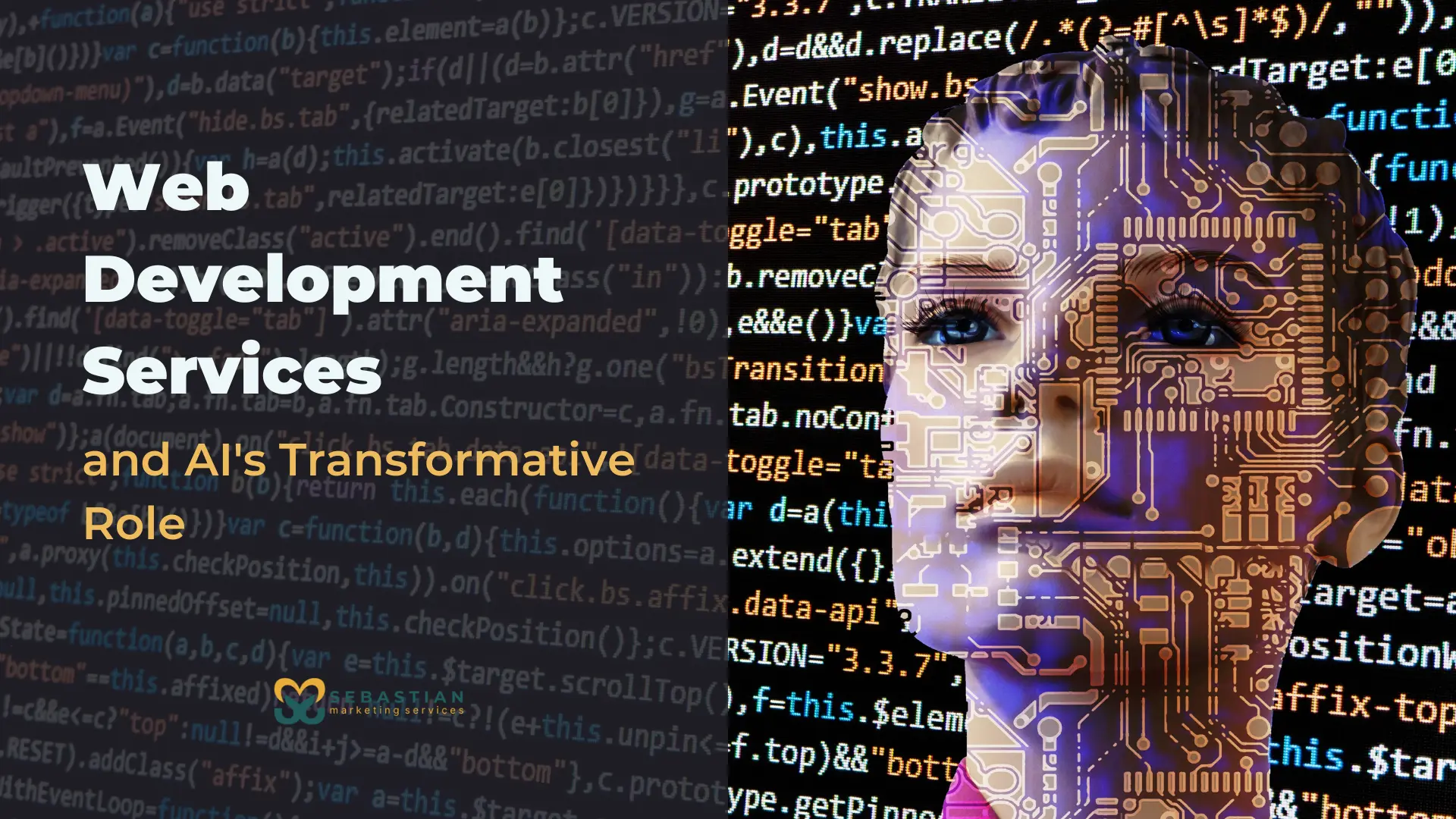Having a strong online presence is vital for businesses, professionals, and everyone who wants to be known. Web development services is at the core of this digital transformation.
So, what exactly are web development services? Why is web development so important, and how is the emergence of artificial intelligence (AI) influencing its future?
1. Web Development Services Defined
Web development services include several tasks and processes that contribute to the creation, maintenance, and optimization of websites or web applications.
These services are typically offered by web developers, who use a variety of programming languages, tools, and technologies to enhance the functionality, appearance, and user experience of a website.
Web development services can be broadly categorized into two areas – front-end development, which focuses on the website’s user interface and design, and back-end development, which is concerned with server-side infrastructure and database management.
Why are Web Development Services important?
Web development plays a crucial role in determining the success and growth of businesses and organizations.
Well-crafted web development services offer several benefits, like the following:
1. Accessibility – A well-designed website ensures that products, services, and information are easily accessible to users across different devices and platforms.
2. Branding and credibility – A professionally designed website establishes a strong online presence, helping to build brand recognition and credibility.
3. User engagement – High-quality web development services create interactive and engaging websites, encouraging users to spend more time exploring the content.
4. Conversion and sales – Effective web development can lead to increased conversion rates, driving more sales and revenue for businesses.
5. Search engine optimization (SEO) – Properly structured and optimized websites are more likely to rank higher in search engine results, increasing visibility and organic traffic.
- 1. Web Development Services Defined
- Why are Web Development Services important?
- 2. The Growing Influence of Artificial Intelligence (AI) in Web Development
- 3. Brief History of Web Development Services
- 4. The Impact of AI on Web Development Services
- 5. Integrating AI with Web Development Services
- 6. Ethics and Considerations in AI-Driven Web Development
- 7. AI-powered Web Development Workflows
- 8. Future Trends in Web Development Services and AI
- 9. Embracing AI – The Future of Web Development Unveiled
2. The Growing Influence of Artificial Intelligence (AI) in Web Development
The integration of artificial intelligence (AI) into web development services is transforming the way websites are designed, built, and maintained.
AI-driven tools and technologies are assisting developers in automating tasks, tailoring user experiences, and enhancing website performance.
Some instances of AI in web development include:
1. AI-assisted Design Platforms
These tools utilize AI algorithms to generate website designs based on user preferences, significantly reducing the time and effort needed to craft visually appealing websites.
2. AI-powered Chatbots and Virtual Assistants
Chatbots and virtual assistants, supported by natural language processing (NLP) and machine learning, allow websites to provide personalized customer support and guidance, improving user experience and satisfaction.
3. AI-driven Optimization
AI technologies can analyze website performance data, pinpoint areas for improvement, and automatically implement optimizations to boost loading times, accessibility, and user engagement.
As AI continues to advance, its impact on web development services will only grow, offering new possibilities for creating more intelligent, efficient, and user-friendly websites.
3. Brief History of Web Development Services
The web development services landscape has evolved significantly since the dawn of the World Wide Web.
Here are key milestones in the evolution of web development technologies, design practices, and frameworks that have shaped the industry.
3.1 Evolution of Web Development Technologies
HTML, CSS, JavaScript
The early days of web development were marked by the creation and adoption of fundamental technologies, such as HTML, CSS, and JavaScript.
HTML (Hypertext Markup Language) provided the basic structure and content of websites, while CSS (Cascading Style Sheets) enabled developers to apply consistent styling across pages.
JavaScript emerged as the go-to programming language for adding interactivity and dynamic content to websites, solidifying its place in web development services.
Server-side Languages (e.g., PHP, Python, Ruby)
As websites grew in complexity, the need for server-side languages arose to handle more sophisticated tasks, such as database management, user authentication, and server-side processing.
PHP, Python, and Ruby emerged as popular server-side languages, each offering unique advantages and capabilities for web developers.
These languages facilitated the creation of more dynamic and interactive websites, further expanding the scope of web development services.
3.2 Evolution of Web Design Practices
Responsive Design
With the rapid increase in mobile device usage, responsive design emerged as a critical web development practice.
Responsive design ensures that websites automatically adjust their layout and appearance based on the user’s device and screen size, providing an optimal browsing experience across desktops, tablets, and smartphones.
As a result, web development services now prioritize creating responsive designs to cater to the diverse needs of users.
Mobile-first Approach
In response to the growing dominance of mobile devices, the mobile-first approach became a popular web design strategy.
This approach prioritizes designing websites for mobile devices before scaling up to larger screens, ensuring that websites deliver an excellent user experience on smartphones and tablets.
Web development services have embraced the mobile-first approach, recognizing the importance of reaching users across various devices.
Emergence of Web Development Frameworks and Tools
1. Front-end frameworks (e.g., Bootstrap, Angular, React)
The rise of front-end frameworks, such as Bootstrap, Angular, and React, has revolutionized web development services by providing reusable, modular code structures and components.
These frameworks streamline the development process, enabling developers to create highly interactive and visually appealing websites more efficiently.
These frameworks help ensure consistency and best practices across projects, resulting in higher-quality web experiences.
2. Back-end frameworks (e.g., Django, Ruby on Rails, Express)
Similar to front-end frameworks, back-end frameworks like Django, Ruby on Rails, and Express have significantly impacted web development services.
These frameworks provide a structured approach to server-side development, simplifying tasks such as database management, user authentication, and routing.
By leveraging back-end frameworks, web developers can create more efficient and maintainable web applications, further enhancing the quality and scope of web development services.
4. The Impact of AI on Web Development Services
The integration of artificial intelligence (AI) into web development services is transforming the way websites are designed, built, and maintained.
Here are various applications of AI in web design tools, user experience (UX) and user interface (UI) design, and web performance optimization.
4.1 AI-driven Web Design Tools
1. AI-assisted Web Design Platforms
AI-assisted web design platforms, such as Wix ADI, The Grid, and Firedrop, leverage machine learning algorithms to generate website designs based on user preferences, significantly reducing the time and effort required to create visually appealing websites.
These platforms analyze design trends, color schemes, and user behavior to create personalized and responsive web designs, streamlining the web development process and allowing developers to focus on more complex tasks.
2. Benefits and Limitations of AI-driven Web Design Tools
Benefits
Improved efficiency – AI-driven web design tools automate the design process, enabling web developers to create websites faster and more efficiently.
Personalization – AI algorithms analyze user preferences and behavior, generating personalized designs that cater to individual tastes and requirements.
Consistency – AI-driven tools ensure consistency in design elements, leading to a more cohesive user experience.
Limitations
Lack of creativity – AI-generated designs may lack the creativity and originality that human designers can bring to the table.
Limited customization – AI-driven tools may not offer the same level of customization and flexibility as traditional web development services.
Dependence on data – AI algorithms rely heavily on data, which may limit their effectiveness in niche industries or for unique design requirements.
4.2 AI in User Experience (UX) and User Interface (UI) Design
1. AI-generated Personalized Content
AI can be used to create personalized content for users based on their browsing history, preferences, and behavior.
By analyzing data, AI algorithms can tailor website content, layout, and recommendations to deliver a more engaging and relevant user experience.
This personalization leads to higher user satisfaction and increased conversion rates for businesses leveraging web development services.
2. AI-powered Chatbots and Virtual Assistants
AI-powered chatbots and virtual assistants, driven by natural language processing (NLP) and machine learning, enable websites to offer personalized customer support and guidance.
By providing real-time assistance and answering user queries, these chatbots and virtual assistants enhance user experience and satisfaction, further elevating the value of web development services.
4.3 AI in Web Performance Optimization
1. Image and video compression.
2. AI algorithms can be used to optimize images and videos on websites, reducing file sizes without compromising visual quality. This results in faster load times and improved website performance, which is crucial for user experience and search engine rankings.
3. Load balancing and traffic management
4. AI-driven load balancing and traffic management solutions can analyze and predict website traffic patterns, dynamically allocating server resources to handle traffic spikes and minimize downtime.
By optimizing server performance, AI helps ensure a smooth and responsive user experience, enhancing the overall effectiveness of web development services.
5. Integrating AI with Web Development Services
As AI continues to make inroads in the web development industry, it is essential to understand how to effectively integrate AI technologies into web development services.
Here are the right AI tools and technologies, ethical considerations in AI-driven web development, and AI-powered web development workflows.
Choosing the Right AI Tools and Technologies
1. Machine Learning Libraries and Frameworks
Selecting the appropriate machine learning libraries and frameworks is vital for successful AI integration in web development services.
Popular libraries, such as TensorFlow, PyTorch, and scikit-learn, offer pre-built algorithms and tools for various AI applications, including image recognition, natural language processing, and data analysis.
These libraries can be used in conjunction with popular web development languages, such as Python and JavaScript, to build AI-driven web applications.
2. AI APIs and Cloud Services
AI APIs and cloud services, such as Google Cloud AI, IBM Watson, and Amazon AWS AI, provide access to pre-trained AI models and services that can be easily integrated into web development projects.
These APIs and services offer functionalities, such as computer vision, natural language processing, and recommendation engines, without requiring in-depth knowledge of AI algorithms or significant computational resources.
6. Ethics and Considerations in AI-Driven Web Development
6.1 Data Privacy and Security
As AI-driven web development services rely heavily on user data, it is crucial to prioritize data privacy and security.
Ensure that data collection, storage, and processing practices comply with relevant data protection laws, such as GDPR and CCPA. Additionally, implement robust security measures to protect user data from unauthorized access and breaches.
6.2 Responsible AI Usage and Transparency
Responsible AI usage in web development services involves being transparent about the use of AI on websites and ensuring that AI algorithms do not perpetuate biases or discriminate against users.
Implement measures to audit and monitor AI models for fairness and accuracy and strive to create inclusive and accessible web experiences for all users.
7. AI-powered Web Development Workflows
7.1 Automated Testing and Debugging
AI can be used to enhance web development workflows by automating testing and debugging processes.
Machine learning algorithms can analyze code, identify potential bugs, and suggest fixes, streamlining the development process and improving code quality.
AI-driven testing tools can also simulate user interactions, providing insights into potential usability issues and areas for improvement.
7.2 AI-assisted Code Generation and Refactoring
AI-assisted code generation tools, such as GitHub Copilot and Kite, can analyze existing code and provide suggestions for new code snippets or refactoring, enhancing developer productivity and code quality.
These tools leverage AI algorithms to understand coding patterns and best practices, enabling web developers to write cleaner, more efficient code, ultimately enhancing the overall quality of web development services.
8. Future Trends in Web Development Services and AI
As AI continues to evolve, its impact on web development services will only grow, offering new possibilities and shaping the future of the industry.
Here are some of the emerging trends in AI-driven web design, web accessibility and inclusivity, and the role of AI in cutting-edge web technologies.
8.1 Advancements in AI-driven Web Design
1. Generative Adversarial Networks (GANs) for Web Design
Generative Adversarial Networks (GANs) are a class of machine learning algorithms that can generate realistic content by pitting two neural networks against each other.
In the context of web development services, GANs have the potential to revolutionize web design by creating unique and visually appealing designs, layouts, and visual elements, pushing the boundaries of creativity and personalization in web design.
2. AI-generated 3D Graphics and Animations
AI-driven tools and technologies can be leveraged to create realistic 3D graphics and animations for websites, enhancing the user experience and offering new ways to engage and interact with online content.
As AI-generated 3D visuals become more sophisticated and accessible, they will likely play a more significant role in web development services, transforming the look and feel of websites.
8.2 AI in Web Accessibility and Inclusivity
1. AI-powered Accessibility Tools
AI-powered accessibility tools can analyze websites and identify potential barriers for users with disabilities, offering recommendations for improvements to ensure a more inclusive and accessible user experience.
These tools can also be integrated into web development services, streamlining the process of creating websites that cater to a diverse range of users and abilities.
2. Inclusive Design Powered by AI
AI can be used to analyze user behavior and preferences, enabling web developers to create more inclusive designs that cater to the unique needs of different user groups.
By leveraging AI-driven insights, web development services can create websites that are not only visually appealing but also promote accessibility and inclusivity for all users.
8.3 The Role of AI in Emerging Web Technologies
1. Web 3.0 and the Semantic Web
Web 3.0, often referred to as the Semantic Web, aims to create a more intelligent, interconnected, and personalized online experience.
AI will play a crucial role in realizing this vision by enabling websites to understand and interpret user data, context, and preferences, delivering more personalized and relevant content.
Web development services will need to adapt and integrate AI-driven technologies to stay ahead of the curve in the Web 3.0 era.
2. AI Integration with Internet of Things (IoT) and Edge Computing
As the Internet of Things (IoT) continues to expand, web development services will need to consider the integration of AI with IoT devices and edge computing.
AI-driven algorithms can be used to process and analyze data from IoT devices in real-time, enabling smarter decision-making and more efficient resource management.
Web developers will need to embrace these emerging technologies and incorporate AI-driven solutions to create innovative and interconnected web experiences.
9. Embracing AI – The Future of Web Development Unveiled
The landscape of web development services is undergoing a paradigm shift, thanks to the transformative impact of artificial intelligence.
Here’s a recap of the significant influence of AI on web development services and discuss the importance of embracing AI in web development practices and preparing for the future of the industry.
9.1 The Transformative Impact of AI on Web Development Services
AI has revolutionized various aspects of web development services, from automating web design processes to enhancing user experience through personalization and improving website performance.
The integration of AI-driven tools and technologies is enabling web developers to create more engaging, accessible, and efficient web experiences, pushing the boundaries of what is possible in the digital space.
9.2 Embracing AI in Web Development Practices
To stay ahead of the curve, web development services must embrace AI-driven technologies and methodologies, integrating them into existing practices and workflows.
This includes selecting the right AI tools and libraries, ensuring responsible AI usage and data privacy, and adopting AI-powered workflows to streamline development processes and enhance the overall quality of web projects.
9.3 Preparing for the Future of Web Development Services and AI
As AI continues to evolve and shape the future of web development services, it is essential for web developers and businesses to stay informed of emerging trends and advancements.
This includes staying abreast of advancements in AI-driven web design, exploring AI’s role in web accessibility and inclusivity, and understanding the potential of AI in emerging web technologies like Web 3.0, IoT, and edge computing.
By staying informed and adapting to these changes, web development services can capitalize on the opportunities presented by AI and continue to create innovative, engaging, and impactful digital experiences.
Interested in leveraging AI for your web development needs?
Get in touch with us through to learn more about how we can help you stay ahead in the digital space.
We look forward to hearing from you!



